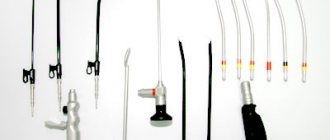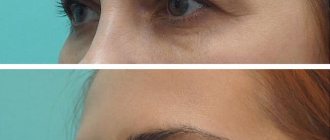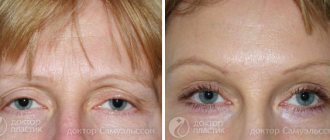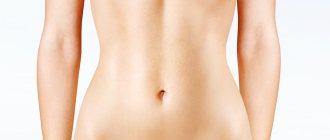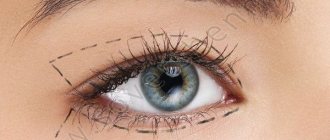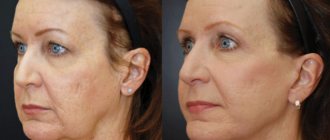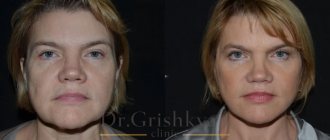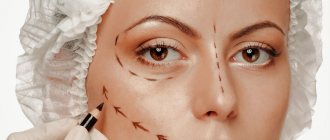Indications Contraindications Preparation Types of operations Recovery
Many patients turn to a plastic surgeon when they need frontal surgery of the forehead or brow ridges. This term refers to a whole range of different intervention methods used by plastic surgeons to change the shape and eliminate various cosmetic defects in the brow ridge or frontal area. Forehead reduction surgery allows you to correct facial asymmetry and increase the projection of the frontal tuberosities.
Indications for forehead and eyebrow plastic surgery
The key indication for frontoplasty is the patient’s desire; if he is not satisfied with the appearance of the forehead and face as a whole, this brings him psychological discomfort and creates complexes. Indications for intervention:
- the presence of asymmetry of the forehead in relation to the rest of the face;
- deformations in the forehead, undesirable defects of bone structures;
- very large or too low forehead;
- post-traumatic or congenital defects in the area of the frontal bone.
In addition to performing forehead frontoplasty, the doctor can also correct soft tissues, eliminating wrinkles, which gives a rejuvenating effect.
Endoscopic lifting of the forehead, eyebrows, temporal areas
Anton Zakharov: Hello, friends. Let's talk to you about such an operation as endoscopic lifting of the forehead, eyebrows, and temporal areas. This is quite a long title. It has many synonyms, such as forehead endolift, upper third endoscopy, forehead endoscopy or endoscopic frontotemporal lift. These are all synonyms; different surgeons use different phrases to refer to this intervention. Although the optimal name and full-fledged one is endoscopic lifting of the forehead, eyebrows, and temporal areas. What is hidden under this long phrase? This is a modern high-tech operation that allows you to cope with a number of aesthetic imperfections in the upper third of the face. The main indication is drooping of the eyebrows.
Let me remind you that there are two anatomical zones from eyelashes to eyebrows. The upper eyelids are from the eyelashes to the crease, and from the crease to the eyebrows is the subeyebrow. And very often, patients turn to an aesthetic surgeon, having this aesthetic defect - ptosis of the subeyebrow, with the desire to perform upper aesthetic blepharoplasty. But this is not a very reasonable wish. And the surgeon, if he has a sufficient level of qualification, he understands that the ptosis of the subeyebrow must be corrected by another method, such as endoscopy, and performs precisely this intervention.
Also an indication for endoscopic lifting is excess skin in the temporal region, the so-called “crow’s feet”, or low forehead height. Because this operation is often used as a harmonizing intervention in order to increase the height of the upper third of the face as a whole, which for many faces makes it possible to set the correct heights and obtain a more advantageous composition.
The intervention is carried out through five punctures in the scalp, two in the temporal region, two in the parietal region and one in the center. And the big advantage of this operation is that there are no open accesses on the face. That is, no scars remain after this intervention on the visible parts of the face, everything is in the scalp. Ideally, hair is not removed, nothing is shaved, just local partings are made. This allows our patients to return to social life very quickly. And also this intervention is one of the fastest to recover from facial surgeries. Rehabilitation generally takes 7-10 days, of which the person spends 5 days wearing a bandage on his face.
Through these five approaches that we are discussing, the surgeon uses endoscopic equipment to enter the upper third of the face, disassemble all the ligaments that fix the tissues in their current position, move them to a more correct, more advantageous position or with an increase in the hairline in terms of height correction thirds, either straightening the subeyebrow or correcting the symmetry of the eyebrows, which is also an indication for endoscopic lifting and fixes the tissues in a new position.
Typically, modern fixatives made from polylactic acid are used for this, they are called endotins.
There are several outdated methods of fixation, such as bone screws, which are temporarily installed for 10 days to secure the tissue in a new position, or thread methods for fixing displaced tissue, which are much less effective than fixators and, unfortunately, cannot provide a stable result of this operation. Especially the screws. Because dense, hard scar tissue, which holds the tissue in a new position, takes two to three months to form. Screws removed after 10 days no longer hold anything and, accordingly, very often the tissue returns to its place. Therefore, in society there is a rather skeptical attitude towards this operation, precisely due to the use of unreliable fixation methods. If the fixation is complete, then the stability and results of these interventions are very great.
This operation, of course, is considered, on the one hand, as rejuvenating, eliminating ptosis of the subeyebrow, age-related changes in the upper third, and harmonizing by putting the thirds in the correct ratio. This comprehensive approach allows us to achieve optimal aesthetic results, and is what we use in our practice.
Very often, endoscopic lifting is used as an isolated intervention, that is, it is performed separately and not combined with other operations. In many cases it is part of a complex periorbital surgery. There were a number of separate videos about such an integrated approach, which you can find on the channel.
And in the context of complex interventions, this is also a common practice; endoscopy is actively used. But we rely on individual facial anatomy in our tactics. And depending on what complaints the patient comes with, we can perform this intervention either separately or as part of more extensive interventions on the face.
This intervention allows us to position the eyebrows the way we like with the patient to create an optimal composition. Therefore, it is with the help of endoscopy that it is possible to change the compositional position of the eyebrows to obtain optimal results, either in accordance with the vision of our patient, so as not to do a tattoo, not to engage in any kind of shape correction, so that the eyebrows are in a stable position for a long time.
Another advantage of high-quality endoscopy is the duration of the effect. Because the result remains stable for 7-10 years after these operations, if everything is done according to technology.
I would like to draw your attention. Endoscopy is very often necessary for those people who think they need upper blepharoplasty. Therefore, it will be great if you discuss your wishes in detail with a professional aesthetic surgeon, who will already select the right tactics to solve your problem.
Contraindications to forehead reduction and plastic surgery
Before performing frontoplasty, a full examination and consultation with a plastic surgeon is necessary to exclude possible contraindications. This is important to avoid complications and irreversible changes after the intervention. Thus, the operation is not performed if:
- this is a patient under 18 years of age;
- there are chronic diseases in the stage of exacerbation or decompensation;
- HIV infection or oncology is detected;
- Frontal sinusitis (inflammation of the frontal sinus) was detected.
If the development of the facial skeleton is not yet complete, there are skin problems in the operation area, serious illnesses have worsened, there are signs of ARVI or general malaise; during pregnancy and lactation, the operation will be temporarily postponed.
Who is this procedure contraindicated for?
- persons under 18 years of age;
- patients suffering from cancer;
- patients who experience inflammatory processes in the tissues involved in the operation;
- people who have impaired blood clotting, as well as those who take medications that reduce it;
- patients with diabetes mellitus, as well as various infectious diseases.
Before you decide to have surgery, you will need to meet with the surgeon (if necessary, there may be several such conversations). Discuss with your doctor all possible options for carrying out the procedure, study in detail the theoretical material that the specialist will recommend to you. Talk to people who have already had positive experiences with similar plastic interventions. Complete all necessary examinations and arrange for a simulation.
Preparation
After consultation to determine the price of frontal surgery of the forehead or brow ridges, preoperative preparation is necessary. In addition to all tests, consultations with a therapist, ENT doctor and anesthesiologist, it is necessary to perform radiographs in lateral and direct projections. They help the surgeon evaluate the shape of the sinuses, their true size, the thickness of the bony septa and the location of the anatomical structures.
The peculiarities of frontoplasty are that the doctor has clear anatomical points, works in the intervention area without affecting the circulatory areas and nerves, which helps to recover faster. Access along the area of hair growth helps to hide the future scar, and detachments of deep layers of tissue mask swelling and possible hematomas.
Indications for surgery
You should think about forehead and eyebrow lift surgery if such unpleasant signs of aging appear as a “stern” look due to incorrect eyebrow position, wrinkles in the corners of the eyes, or a vertical fold at the base of the bridge of the nose. All these phenomena are associated with age-related changes. The face loses its fat layer, which maintains its volume, and when it loses its elasticity, the soft tissues gradually sag.
A forehead and eyebrow lift will help cope with problems such as:
- pronounced facial asymmetry;
- wrinkles in the outer corners of the eyes;
- drooping and drooping eyelids.
However, most patients also expect wrinkles to be smoothed out. A proper lift can even get rid of deep grooves on the skin, not to mention mild facial changes.
Types of operations to correct the shape of the forehead
You can reduce your forehead using plastic surgery through several options for operations and interventions.
Hairline transfer
This is one of the simplest forehead surgery procedures. The doctor excises a strip of skin along the hair growth area, thereby reducing the height of the forehead area or correcting bald patches. It is possible to excise a small fragment in the scalp, moving the hairline a little higher. During surgery, the doctor can adjust the soft tissue by raising the eyebrow area, thereby visually increasing the size of the forehead.
Working with bone structures
With this type of intervention, operations can be performed to reduce the size of the forehead or increase it. If this is an increase in size, implantation is used to build up the bone; if it decreases, a partial osteotomy or bone grinding is performed. This manipulation will be quite enough for a slight correction of the forehead or a change in its relief. If it is necessary to significantly change the volume of bone tissue or adjust the relief, osteotomy will be used, crushing bones with the assembly of a new forehead shape. At the same time as working on the bone part, the doctor also corrects the soft tissues, including the hairline.
How does it go?
As with any such surgery, to reduce any area, you will need to either move individual bones or remove some parts of them. As for the required expansion of the area, it occurs through one’s own tissues or through the use of silicone implants.
Plastic surgery on the forehead is performed in two versions. In the first case, the frontal bone is “transferred” slightly back. In the second, the frontal bone, on the contrary, is pushed forward. In this case, the surgeon does not touch the intracranial part of the head. If the frontal bone needs to be pushed forward, the doctor will use an implant.
It is important that during this procedure the specialist focuses not only on the center of the forehead, but on the entire face. It is necessary to take into account the jawline, the location of the nose and cheekbones in order to create uniform proportions.
Recovery after surgery
Immediately after completion of the plastic surgery, a rehabilitation period begins with the patient’s gradual recovery. The duration depends on the type of intervention and the volume of structures affected. On average, complete recovery takes up to 3-4 months, which depends on the features of forehead surgery - reduction or increase of bone tissue, work with soft tissues.
During the rehabilitation period, swelling and a feeling of heaviness occur above the eyes, which disappear within two weeks after the intervention.
Pain in the intervention sites is typical for 3-5 days after plastic surgery, which is eliminated with analgesics.
It is acceptable to reduce the sensitivity of those areas where the intervention was performed. It disappears within a couple of months. If you follow the doctor's recommendations and all preventive measures, you can return to your normal lifestyle after 2-3 weeks.
Postoperative period. What should the patient prepare for?
Like any complex operation, forehead plastic surgery (see photo) has a number of not very pleasant consequences. They are not so much painful as aesthetically unattractive:
- a slight heaviness appears in the eye area. This occurs because the frontal tissues swell;
- during the first three to four months the patient experiences decreased sensitivity, but over time it returns to normal;
- discomfort, pain for a number of days after the operation.
Any disruption of natural processes in the body, and especially such a procedure, cannot pass without leaving a trace. It will take time and effort to recover. You need to be prepared in advance for the fact that your lifestyle will change noticeably and you may even have to not go to work during the first postoperative month.
Strictly follow all the recommendations of your attending physician and come to the clinic as often as possible to undergo examinations and receive advice.
Temporal brow lift
A temporal (lateral) brow lift is aimed at eliminating wrinkles in the outer corners of the eyes and lifting the outer ends of the eyebrows. Surgical incisions are made in the temporal areas of the scalp. Ideal for patients with limited signs of aging of the forehead skin who require lifting of only the outer edge of the eyebrow without drooping of the inner part.
Temporal lift cannot be used to correct forehead wrinkles. A lateral brow lift is often performed on bald men or on patients who want to “touch up” a previous brow lift. Read more about temporal brow lift.
Who is indicated for frontoplasty?
If women and men are unhappy with their forehead shape and believe that changing its shape will help them look more feminine or masculine, they decide to undergo surgery - frontoplasty. With this operation you can make the following changes to your appearance:
- Change high or low forehead;
- Make the forehead not so convex or protruding (hanging) forward;
- Eliminate asymmetry of the brow ridges;
- Remove forehead defects (wrinkles, depressions, etc.)
Initially, this operation was carried out as part of a set of procedures for transsexuals during gender reassignment. With the help of frontoplasty, men were given feminine features, and women – masculine ones. Today, this operation is performed not only by those who have decided to change their sex, but also by those people who want to correct their appearance.
Post-procedure care and recommendations
After plastic surgery, a person needs about 3-4 weeks to recover. In the case of the injection method, it is enough not to touch the puncture sites with your hands, not to take hot baths and not to be in the sun. Recovery occurs within a week.
During surgery there will be swelling and hematomas, but this will all go away in a couple of weeks. It is at this time that the stitches are removed. In certain parts of the head, sensitivity disappears, which appears after 1-3 months. For quick rehabilitation, you need to take painkillers and anti-inflammatory pills.
Reviews
You rarely come across reviews about frontoplasty, since this operation is not very popular and in demand. Even experts recommend carrying it out only in cases of real need.
- I am very glad that today you can change the shape of your forehead. It’s one thing for men to have such a forehead, but for a woman, a “male” forehead is a complex thing. I always tried to hide it behind my bangs. After the operation I became more confident. Of course, I had to go through everything: swelling, bruises, pain. But after six months everything was completely restored. Elena.
- I decided to undergo frontoplasty, although I came to the doctor with the problem of a deviated nasal septum. An hour before the operation, the doctor came into the room, collected my hair in a bun, and marked with a marker where the incision would be. Later, the nurse took me to the operating room. Anesthesia was administered. All. I don't remember anything else. I woke up with a tight bandage on my head. I only bled for one day. The next day the bandage was removed. The swelling lasted for a long time. It took at least an hour and a half to wash the blood from my hair. There was severe swelling on the forehead. Nothing hurt, the painkillers did their job. Denis.
The surgical technique is clear, rehabilitation is successful, and the results satisfy even the most fastidious patients. Therefore, if you decide to have frontoplasty, look for experienced surgeons and a trusted clinic.
Author - Yulia Spiridonova, website www.sympaty.net - Beautiful and Successful. The article was checked by a practicing family doctor Elizaveta Anatolyevna Krizhanovskaya, work experience - 5 years. More information about the site's authors Copying this article is prohibited!
Endoscopic forehead lift (frontotemporal lift)
An endoscopic forehead lift is a minimally invasive intervention aimed at rejuvenating and improving the aesthetics of the upper third of the face, in which the surgeon’s main instrument is a special optical device (endoscope). During the procedure, video assistance is provided, which allows detailed control of the operation and avoid unnecessary tissue trauma.
The main indications for this type of intervention are the following problems and conditions:
- Drooping corners of the eyes
- “Heavy” gaze due to drooping of one or both eyelids (ptosis)
- Wrinkles, folds, creases in the frontal area, including pronounced ones
- Low eyebrow line
- Gravitational ptosis of tissues, overhanging skin over the bridge of the nose
- Sagging skin and other signs of aging in the upper third of the face
The endoscopic lifting procedure helps to “open” the eyes, smooth out wrinkles, tighten the skin of the forehead and cheekbones, and lift the outer tips of the eyebrows and corners of the eyes. Facial features after endoscopic lifting become more expressive, the face itself looks much younger and fresher.
In some cases, transconjunctival blepharoplasty is also used to correct the lower eyelid area. This type of blepharoplasty allows you to eliminate fatty hernias and bags under the eyes without incisions

